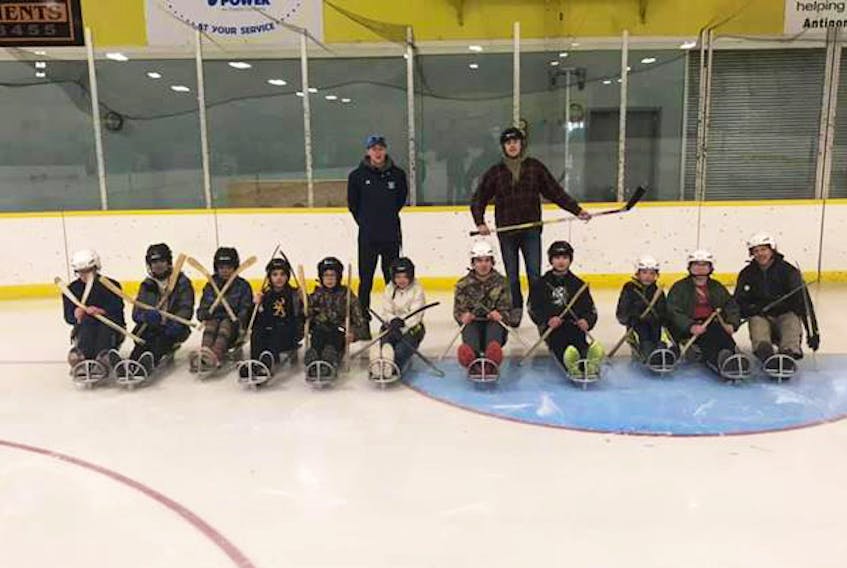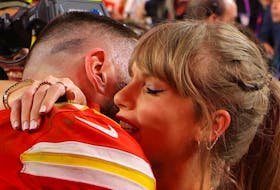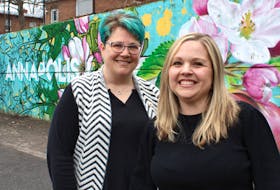SHERBROOKE, N.S. — Introducing the Bulldogs sledge hockey program to an area even more rural than its home in Antigonish, was part of the impetus of a demonstration of the sport taking place at St. Mary’s Education Centre/Academy (SMECA) earlier this month.
“Amanda [Casey, St. F.X. human kinetics professor, program originator] approached me at the hockey rink one day asking if I would be interested in jumping on board to shed some light on the sport, and give the game of sledge hockey some exposure with the hockey players I coach,” SMECA principal Mike MacIsaac said.
“I thought it was a wonderful idea at the time and, after some thought, I wanted to see if I could pursue the same opportunity for our students at my school in Sherbrooke. From there, we planned the day and two St. F.X. human kinetics students - Liam Saxon and Brent Ashfield - helped facilitate the sessions alongside our physical education staff.”
MacIsaac said when he approached the physical education teachers about promoting inclusion in sport using sledge hockey – more and more referred to as ‘para ice hockey’ – “they were on-board from the start.”
“We discussed several opportunities to meet the same outcome but felt, this sport, really promoted inclusion and the belief that no one should be left out of a game,” MacIsaac said.
“To adapt an activity and make modifications to include everyone was the key for us. We had various classes, from Grade 4 through 12, which worked out very well; all ages were able to participate and enjoyed every minute.”

One SMECA student, Quinten Mailman, was part of the Bulldog program, but it was new to the rest of the students.
“The rest of our students had no knowledge about sledge hockey at all,” MacIsaac said. “Some students viewed the sport on TV, but most were quite curious when getting their first look at the equipment and the challenges they may face when trying to maneuver the sleds.
“Some of the students who play hockey were quite shocked when they tried it; they thought it was going to be easy. Sledge hockey was a great equalizer. Overall, the students said they had great fun and wanted to continue to participate in activities, such as this one, in the future.”
Educational aspects
Both MacIsaac and Casey talked about the educational aspect of introducing the sport to the students.
“Our goal was to identify an inclusive physical activity (sledge hockey) which embraced community and acceptance,” MacIsaac said. “We made it a priority to give our students an opportunity/alternative to learn more about sledge hockey which fosters an environment integrating equity, accessibility and inclusion.
“The staff did an exceptional job giving exposure to the sport as well as identifying the equipment, rules and history of the game on a level playing field.”
He noted the sport encourages able-bodied and physically disabled athletes to play “side-by-side.”
“It allows students to compete on a level playing field where disabilities are not disadvantages; and can be a fun, memorable and unique way for our students to connect with their peers,” MacIsaac said. “This was a chance to educate our students when the opportunity presented itself.
“Our staff at SMECA is very fortunate and thankful to be able to partner with Amanda and the St. F.X. human kinetics department to offer a great learning opportunity for our students, to acquire together.”
Casey talked about what the university students gained.
“We want to show our St. F.X. students that if schools or communities are open to inclusion then we should try to encourage this, especially in more rural areas where there are not as many opportunities,” Casey said. “Sometimes there are a number of barriers and it is important for students to learn that, with collaboration and communication, you can help to overcome these.”

Ashfield described the day as a “demonstration,” adding the goal is to make the program more sustainable and accessible.
“This was a good first-step towards inclusion, but we’re looking to do more of these events to make it more sustainable,” Ashfield, who will be graduating from human kinetics but staying at St. F.X. to get an education degree, said.
Casey talked more about duplicating a day like they had at SMECA.
“In human kinetics, students learn that it is important to maximize physical activity opportunities for all,” she said. “Sometimes this means that, as service providers, you go to the community itself rather than waiting for everyone to come to campus, to provide a service.
“We want sledge hockey to become a sustainable sport in this region rather than a novelty. This is why our program is trying to partner with families, the local minor hockey association (AMHA) and schools to make this known. Mike has been really open to this opportunity and we both want to work to make sure this is not a one-off event.”
She also noted Quinten’s involvement.
“This event gave Quinten the opportunity to showcase his sport and skills to his peers and teach them some tricks; this garnered him the athlete of the week award,” she said.
Inclusive education
Both educators talked more about inclusive education.
“I wanted to make it our priority at SMECA to promote inclusive education and show our students what inclusion looks like,” MacIsaac said.
“It is essential people have a better understanding of inclusive education, which is about ensuring access to quality education for all students by effectively meeting their diverse needs in a way that is responsive, accepting, respectful and supportive.

“We have a strong foundation on which to build, including an extensive obligation to the concept of inclusion itself. It is imperative we have hardworking and creative educators who teach innovative approaches to address challenges students face in today’s society.”
“The social benefits of inclusive physical activity for children with disability, in terms of increased interaction, confidence and awareness, have been well-documented,” Casey said.
“What I find interesting about sledge hockey is that it adds another potential benefit of inclusion for children without disability. Some children may not have learned nor had the opportunity to skate, or have difficulty with skating, despite really liking hockey. Sledge hockey helps overcome this barrier and allows some of the boys and girls to be on the ice and play the game with some of their peers who play hockey more regularly.”









